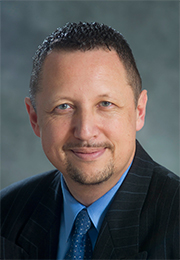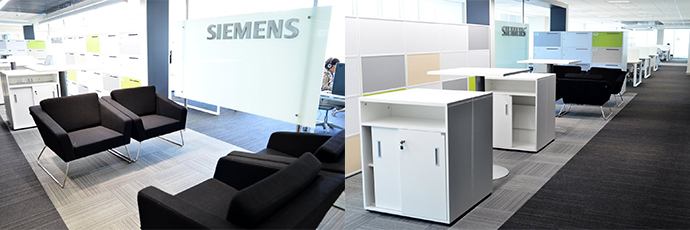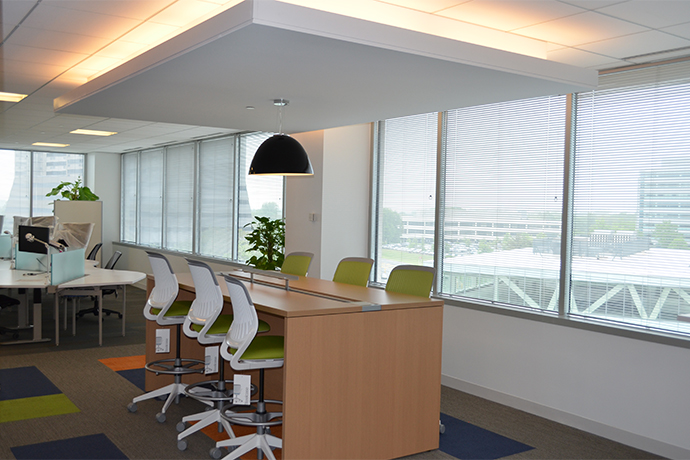
Please, make yourself comfortable. And be ready on a moment’s notice.
The feeling one gets from hearing those not-so-reassuring words is familiar to patients in waiting rooms, soldiers in barracks and professional athletes as the trading deadline approaches. It’s become increasingly familiar to corporate personnel as well — not only because of the nearly constant flow of corporate restructuring, but due to the hour-to-hour needs of their daily work.
Enter the open-plan office, promising the ultimate in flexibility and teamwork, while hopefully eliminating some of those queasy feelings about the impermanence of it all.
According to a study of nearly 1,000 companies by the International Management Facility Association, more than 70 percent of employees in the US now work in open-plan offices — whether they
want to or not. But from all signs, it appears most of the 48,000 Siemens employees currently working in the company’s New Way of Working (NewWoW) open-plan offices at 83 sites in 35 countries are happy about it.
Siemens Real Estate is responsible for worldwide assets worth more than $6 billion and a global workforce of 300,000 employees. Michael Kruklinski, head of Region Americas for Siemens Real Estate, oversees a portfolio encompassing 3.5 million sq. m. (more than 37.6 million sq. ft.) of rentable space across 569 locations, associated with €427 million (US$571 million) in sales. Those locations include the company’s 200-employee regional headquarters for the Americas in Orlando, where Siemens moved two years ago and where he took time this week from his typically busy travel schedule to talk with Site Selection.
“Four to six days a month in the office is a lot,” he says. “I travel quite a bit because real estate for me is a local business. You have to see the sites, and get an impression, and talk to the employees about how we can help them.” That comes in handy when he finds himself pleading a case for making an investment: “I did it once without visiting [the site],” he remembers, “and a simple question wasn’t simple for me to answer.”
A former senior principal at A.T. Kearney, Kruklinski has held a number of senior positions at Siemens during his 20 years there, most recently serving as chief strategy officer and head of corporate development for Siemens Corporation USA. Before the reorganization of the company announced earlier this year, he led the creation of the Siemens Industry Sector, as well as the company’s SmartGrid business unit and eCar initiative. He currently serves on the board of Siemens Real Estate, meaning monthly trips to Germany for meetings are part of his grueling travel regimen.
Siemens has more than 300,000 employees, a fifth of them in the US. By 2017, half the company’s global work force will be working in NewWow. Siemens Real Estate Americas (one of four global regions in the company’s real estate organization) has seen the largest implementation of NewWow of any region, including sites in Chile, Brazil and Canada, as well as US sites in Georgia, Massachusetts, California, New Jersey, Florida, Kentucky and more. Soon their number will include Houston, Texas, where Kruklinski just spent two days performing due diligence for an entirely new Siemens location.
“I practice what we preach — NewWow applies to me,” he says from Orlando, where he makes his home. “We also take it a step further.” In addition to working remotely (by necessity as much as choice), he and two other SRE leaders for the Americas don’t even have offices. Instead, they share two un-personalized open conference rooms.
Earlier Than You Think
Kruklinski says the NewWow concept originated with a site in the Netherlands about six years ago, and was originally branded as Siemens Office, but the name was changed because office was just a piece of the picture.
“It’s a change management program for how we work, manage people, use IT and create work/life balance,” he says, a program that ultimately finds its physical manifestation in the design of the workspace. Sustainability is already pursued as a matter of course at Siemens facilities, so is not unique to NewWow space. While there’s some nuance when it comes to local vendors, the team now works with a pre-selected catalog of furniture choices, down to the colors and feel, as a corporate identity is developed. Furniture brands include Knoll, Steelcase, AllSteel and Humanscale.
“We down-selected to what we would have in our office,” says Kruklinski. “We created showrooms, and invited employees to come and give us feedback.”
High among their preferences were high-top touch-down stations, higher chairs and height-adjustable desks.
“People gravitate to those over a regular desk,” he says. “They like standing up and working. I personally like those too. You stand up, plug in, and you can work that way.”
Change can take time, and that’s okay, if not downright preferred, says Kruklinski, citing a move to a new site in Mexico. “We could start up to a year before we have a physical change,” he says, evaluating everything from proximity of dry cleaning, a gym and catering to the final furniture choices.
Indeed he says, one lesson learned early on was to start that change management process earlier than initially thought, which sometimes had been just a few weeks or months before.
“You can start working with processes in the old environment,” he says. For instance, “We have a lot of cleanup of storage files in the offices. We had big events and parties where people clean out offices and files, either discarding them or putting them in long-term filing.”
“If you make these phone booths too big or comfortable, they become quasi-offices, and people never leave.”
Significant technology training and retraining also was needed, such as how to use voice-over-IP and “follow-me” printing tools. But the biggest lesson thus far, he says, is to avoid a one-size-fits-all approach when it comes to a desk-sharing ratio. Kruklinski’s team found that the initial plan of one desk for every 1.3 employees was lowballing.
“We have vacancy when we do that,” he says. “You can go higher. Now we target 1-to-1.5. On the other hand, we’re not using one size fits all anymore. We’ve created a tool that looks at the job families at a site. For sales you can go 1-to-3 or 1-to-4. But for software engineers and field support, they need to sit at the same desk every day. So we are more sophisticated in acknowledging the job and how they’re doing it.”
As the ratio goes up, he says, the space needs to adjust accordingly.
“You need to have more small meeting rooms, or ‘phone booths’ for private conversations,” he says. “Toronto originally was a 1-to-1.3 ratio, and now it’s going above 1.5, but we are adding phone booths, smaller rooms and think tanks.”
But don’t make those spaces too cozy.
“If you make these phone booths too big or comfortable,” he says, “they become quasi-offices, and people never leave.”

Common Across Cultures
The feedback process for NewWow as it’s been introduced and implemented was formalized from the outset.
“Early on we involve representatives from all the departments that will go through the change,” says Kruklinski. “Each department nominates a change coach.” Those coaches then share high-level floor plans and renderings (including the all-important cafeteria layout) with employees.
More formal feedback occurs in cycles of four to six weeks, with employee polling occurring before implementation, during the change and six months after completion.
“It goes from a very high resistance or uncertainty level, with people worried about noise and privacy and giving up the office, to people who can’t even imagine they ever resisted,” he says. “Five percent or so just don’t like it — they still miss the office, or think it’s too loud. But the vast majority really, really like it and embrace it.”
One might reasonably presume that acceptance of NewWow would vary across different countries and regions, but Kruklinski says some things transcend cultures.
“We’ve done it in North and South America, and anywhere you go, the negative feeling up front quickly turns into a positive experience,” he says. “The implementation itself in South America was easier than it was in the US to a certain degree. It was surprising to me, I have to say. I expected a higher pushback in some cultures, but the acceptance or resistance rate really is the same, no matter the culture or the jobs. The range is not that big, nor is the turnaround [in sentiment].”
As with many corporate real estate issues, he says, it’s about buy-in from the top.
“At the end of the day it’s up to the top management — if they want it and want to live it, and how they embrace it. You face a lot of hurdles, often from middle management, people who have worked for the company for 10 or 20 years, now have an office, and have to give up that office. But managers need new tools — we don’t stand behind a desk anymore.”
The One Constant
In addition to the forthcoming new site in Houston, Kruklinski’s team is currently doing research to transition a site in Princeton, N.J., and consolidate at another location outside Chicago, in Buffalo Grove, Ill. Other NewWow sites are on the way in São Paulo, Brazil, and Lima, Peru. “And we’re going back to Argentina and revisiting what we need to do,” he says. “Is it still the right concept? Do we need to re-remap this after all the lessons learned?”
After all, the one constant is change, whether it’s work, life or work/life balance. Kruklinski says the move to Orlando with the Americas HQ, for instance, occurred because, as the team evaluated a handful of cities, Orlando made the most sense in terms of its internal and external resources, surfeit of Spanish speakers and solid corporate connectivity to Central and South America — all factors related to an evolving and dynamic marketplace.
Similarly, not long ago, Siemens decentralized its real estate organization from Munich into those four regions. “We have a large real estate organization in Iselin [N.J.],” says Kruklinski, “but one reason we didn’t go there was we wanted to signal that this is a new beginning. And sometimes you want to pick a new location to drive change and establish something new.”
Now, as the growing company reorganizes into nine divisions plus healthcare, the ceaseless wave of change will keep unfurling, even as NewWow keeps rolling out. Siemens Real Estate, operated as a P&L and not a cost center, will continue to seek a 50-50 split between owned and leased space, and continue to keep vacancy at a minimum. But beyond those strategic aims, like workers unmoored from their desks, nothing is set in stone.
“I was on a panel once, and Siemens was centralizing,” says Kruklinski. “I was asked which is better, centralized or decentralized, and I said, ‘Yes.’ There’s no perfect form of organization. You always have to look and ask, ‘What’s the best fit right now?’ An organization always needs to be reinventing and rethinking itself.”

